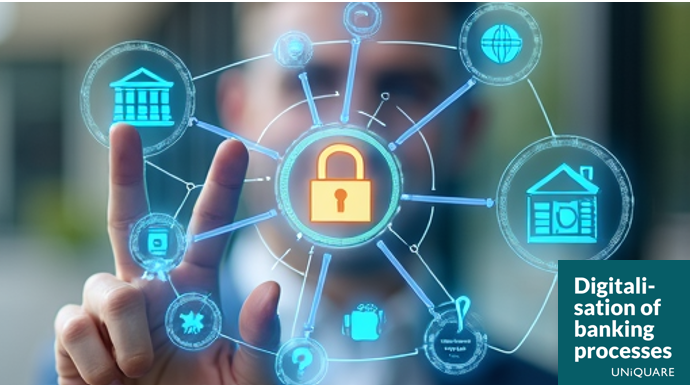ID Austria makes Austria a European leader in digital identities – and it is effective. Banks can process their customers’ identification and legitimation completely digitally, securely, and without media disruption for the first time. This accelerates credit approvals, reduces costs, and raises the customer experience to a new level. Is the leap to a completely digital loan process worthwhile?
Background: Why eID gains relevance for banks
Digitalization is thoroughly changing the expectations of bank customers. Ever more people want to conduct their financial transactions quickly, easily, and securely. This includes loans. This is exactly where electronic identification (eID) comes in. It enables secure, digital, and seamless identity verification – for instance, when opening an account or during the loan process. In order to gain full value from these advantages, banks must adapt their processes all the way: from integration of eID into existing workflows to secure connections to central interfaces.
The eID can be a real game-changer, especially in the credit process. It meets stringent regulatory requirements for identification and documentation. UNiQUARE’s integration expertise can efficiently integrate it into existing processes. The base: the eID is based on official documents and is secured by cryptographic procedures. It is like the Austrian ID card or the German online ID card. We will demonstrate how the eID changes the credit process and outline a credit example below.
Efficiency and security: how eID changes the credit process

Banks can use eID to verify their customers’ identities digitally and in a legally secure way. This ensures compliance with regulatory requirements such as KYC, but also improves the user experience. The seamless data transfer and high legitimacy open new possibilities for digital interactions between banks and customers:
🆔 Prospective applicants can use eID securely identify and authenticate themselves digitally. This is accomplished by direct transmission of verified data such as name, date of birth, place of birth, address, and any degree. The photo of a person is also transmitted. This helps identity verification and makes the entire process more efficient and user-friendly.
📝 The eID enables the digital signature of contracts. Thus, legally secure transactions can be completed entirely digitally. This is particularly relevant for account opening and loan agreements, as a manual or qualified electronic signature (QES) is often required by law. This speeds up processes and consistently avoids media breaks.
🌍 The eID offers the banks the possibility of faster, digital onboarding, even for international customers, and reduces the identification process costs. At the same time, automated, secure identity verification improves compliance and ensures a smoother customer experience in international financial services.
⏳Banks also benefit from the use of electronic seals and time stamps, as they reliably ensure the integrity and authenticity of digital documents. Any manipulation is virtually eliminated, and archiving and traceability are legally compliant.
Practical example: Digital loan conclusion using eID

How does the digital credit process really look? A mortgage financing example shows: the eID makes identification and document verification digital, transparent, and traceable but does the eID really support all process steps?
🔍🤷 Assessment of the requirements & advice: Verified customer data are immediately available. This makes advice more specific and reduces queries. Real estate portals can also be integrated providing up-to-date property data.
🗂️🤷 Document review & application: Identity data are provided automatically, eliminating manual verification. Document verification can also be automated to check for completeness and authenticity.
💳 ✅ Credit check: verified personal data are the basis. Credit agencies, analyses, or open banking models are used for the assessment.
🏠❌ Real estate valuation: Valuation is carried out via specialized platforms based on digitally delivered owner data and relevant documents.
💼❌ Credit approval: the eID ensures fast identification; automated decision platforms perform the risk assessment.
📝✅ Contract signing: thanks to eID and digital signature, the contract can be concluded completely online – conveniently and legally secure.
💸❌ Disbursement: verified account details are available, payment is made via automated payment systems.
📞❌ Ongoing support: Changes to customer data can be done digitally and efficiently in CRM systems.
The strengths of eID lie primarily in identification, data verification, and digital signatures. However, a fully digital credit process requires additional integration – from real estate portals to CRM systems. Only the interaction of these solutions creates efficient, legally compliant, and customer-friendly processes.
Outlook
📈 The use of eID will grow – and not just in the credit business. Austria is already a pioneer with ID Austria, successfully implementing complex use cases. In Germany and Switzerland, widespread use is still in its early stages, but the prospects are promising.
We support banks and financial service providers in making their processes more efficient and future-proof using eID. 🕵️♀️👩💻 We are currently working intensively on implementing the ID Austria interface to provide our customers with seamless access to digital identity solutions. Benefit from our experience and industry knowledge – for greater efficiency, lower costs, and satisfied customers. We are happy to exchange ideas with managers who want to develop their processes. Your suggestions and questions are welcome –we will digitize your banking processes with you.
#DigitalIdentitity #IDAustria #Creditprocess #Innovation #Banking
Note: The creation of the basic version of this article (GPT-4.1) and the featured images (FLUX.1) were supported by AI.

